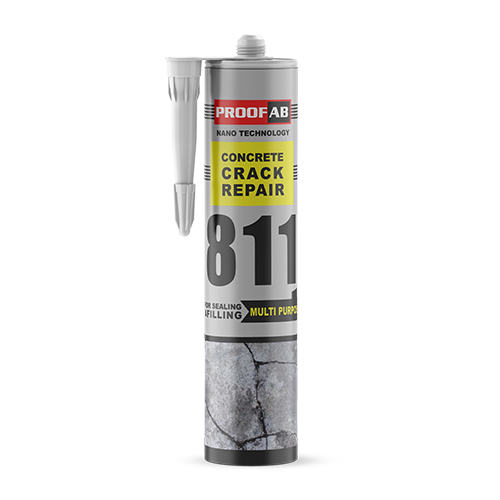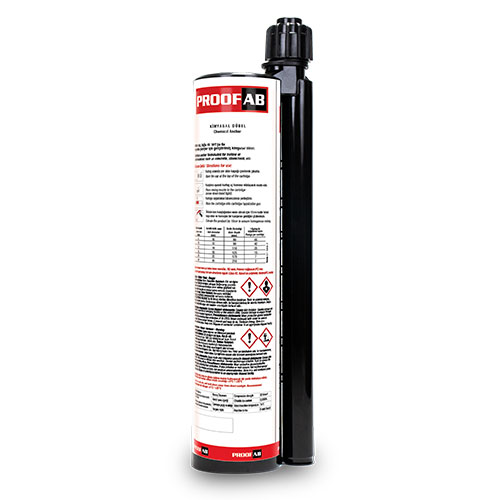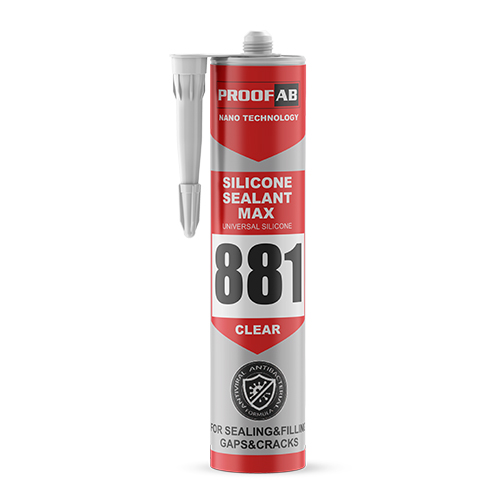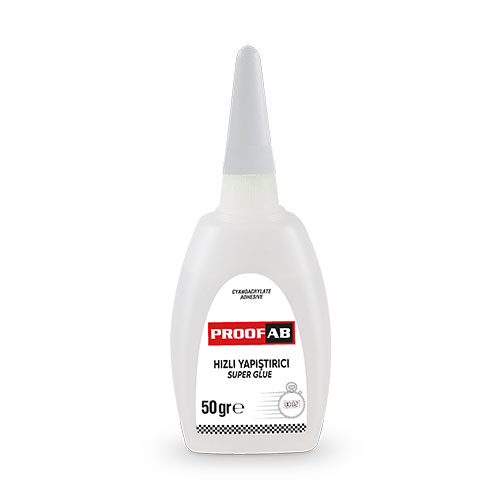PROOFAB Concrete Crack Repair
Description
Description : PROOFAB Concrete Crack Repair 811
A powerful and unique product based on styrene acrylic resins, which is formulated and produced to repair and fill seams and cracks in concrete and cement surfaces, and has appropriate elasticity after drying.

Features and benefits:
- Excellent adhesion to the work surfaces
- Maintaining elasticity properties after drying
- No shedding during execution
- High resistance to thawing and freezing cycles
Application:
- Repairing and sealing surface cracks in concrete
- Can be used on horizontal and vertical surfaces
- Repair and sealing of prefabricated concrete parts
- Suitable for repairing and sealing all concrete structures near drinking water

Technical specification table:
| State of | Thick paste |
| Color | Gray |
| Surface drying time | 2 mm in 1 day |
| Deep drying time | 4 days |
| Thermal resistance | -20°C / +80°C |
| Application temperature | +5°C /+40°C |
| PH | 7-8 |
| Special Weight | 1/06gr/cm3 |
Packing :
300 gr cartridge
Carton of 24 pieces
Product Description – Acrylic Sealant for Concrete Surfaces 811
Acrylic sealant for concrete surfaces is a special and unique product, designed from acrylic styrene resins and micronized fillers and special additives, which is used to repair and fill joints and cracks on concrete, cement and stone surfaces. This product is offered in 350 gram cartridges and is easily applied between cracks and joints by its special guns and then smoothed out with a spatula. This sealant actually plays the role of repairing joints and cracks on concrete, cement and stone surfaces, and due to the presence of a large percentage of acrylic resin in the formulation of this product, it has favorable elasticity and waterproofing properties.
Overall, this sealant is a versatile product used to protect concrete surfaces from various environmental factors. This product is a clear, liquid coating made from acrylic resins. This product is highly durable and long-lasting. The main purpose of this sealant is to protect concrete surfaces from the elements, including weather, water, and stains. It can also be applied to both interior and exterior concrete surfaces. It is much more affordable than silicone and polyurethane options and is also easier to work with. This sealant dries quickly and can be painted over, making it suitable for interior projects where aesthetics are important.
In general, this product is a versatile adhesive that is made up of a combination of silicone-based polymers, resins and additives. The raw material of this adhesive is silicone, a synthetic polymer that is known for its flexibility, heat resistance and chemical resistance. This adhesive can create a strong and flexible bond. This product can be used to seal and fill gaps and cracks where movement occurs.
Sealant packaging for concrete and cement surfaces
300 gram cartridge
Box of 24
Consumption of sealant for concrete surfaces
How much sealant is used for concrete surfaces?
The amount of sealant used on concrete surfaces depends on the depth and width of the crack and joint, and in special circumstances, it can be calculated based on the dimensions of the joint and the specific gravity.
Maintaining acrylic sealant for concrete surfaces
What are the storage conditions for acrylic sealant for concrete surfaces?
Duration: One year in original packaging.
Conditions: Away from cold and frost, heat and direct and prolonged sunlight.
Best storage temperature: +10 to +30 degrees
Safety precautions for sealing concrete and cement surfaces
What are the safety precautions for sealing concrete and cement surfaces?
Tools used with this material should be thoroughly washed with water after work is done.
Keep out of reach of children.
This substance is non-toxic. If you experience any allergic reactions, consult a doctor.
Wear appropriate gloves and a mask when performing.
This material will not cause any harm to the environment.
Method of applying sealant to concrete surfaces
What is the method of applying sealant to concrete surfaces?
Before applying the sealant to repair cement surfaces, the surfaces to be applied must be free of any type of contamination, grease, and dust.
If there is any contamination, clean the surfaces with water pressure or a wire brush.
Scrape out the weak spots in the concrete joint openings with a spatula and slightly open the initial opening of the joint in a diagonal manner.
Place the concrete surface crack sealant into a special injection gun and apply it into the joints and cracks to ensure that the joint or crack is filled.
Use a spatula to smooth the surface until it is completely level.
If there is any unevenness on the surface, it can be sanded with a sandpaper 12 to 24 hours after application to completely level it.
Depending on different weather conditions, 24 to 72 hours after applying the concrete surface joint and crack repair agent, the surface is ready for use and subsequent operations.
Properties and effects of concrete surface sealants
What are the properties and effects of concrete surface sealants?
- Ease of implementation and application on surfaces
- Resistance to limited structural vibrations
- Very high adhesion to the surfaces under the work
- Accelerate drying
- Maintaining elastic properties from hardening
- Very economical and cost-effective
- Excellent resistance to destructive environmental factors
- Excellent sandability
- High resistance to various weather conditions
- Has suitable flexibility properties
- Suitable for use on all horizontal and vertical surfaces.
- High resistance to freeze and thaw cycles
Applications of acrylic sealant for concrete surfaces
What are the uses of acrylic sealant for concrete surfaces?
- Suitable for repairing and sealing all concrete structures in the vicinity of drinking water.
- Sealing and repairing all non-structural joints and cracks on concrete and cement surfaces
- Ability to repair and seal artificial and natural stones
- Suitable for stretching the joints between two walls or where the wall meets the floor.
- Repair and sealing of mosaics, concrete tables, etc.
- Suitable for installation around cement chimneys.
- Repair and sealing of prefabricated concrete parts
- Suitable for use around water inlet and outlet valves and decorative pool lights.
- Repair and sealing of industrial concrete floors such as silos, factories and industrial warehouses
- Suitable for repairing and sealing concrete pool surfaces before insulation and painting.
- Repair and sealing of horizontal surfaces such as concrete floors in parks, walkways, etc.
- Suitable for repairing and sealing water and sewage channels.
- Suitable for sealing concrete tiles and exposed concrete parts.
Physical and chemical properties of acrylic sealant for concrete surfaces
| Color | Gray |
| Physical condition | Pasty |
| Specific gravity | 1/55gr/cm3 |
| Ph | About 8 |
| Chlorine ion | No |
Mechanism of action of acrylic sealant for concrete surfaces
What is the mechanism of action of acrylic sealant for concrete surfaces?
This product is formulated and designed based on acrylic styrene resins and special micronized mineral fillers and, due to its ideal consistency and softness, it easily fills joints and cracks and becomes completely smooth and level after troweling. Due to the high percentage of adhesive in the structure of the concrete surface joint repair, it has very high adhesion to the surfaces under the work and also has good elasticity.






Reviews
There are no reviews yet.